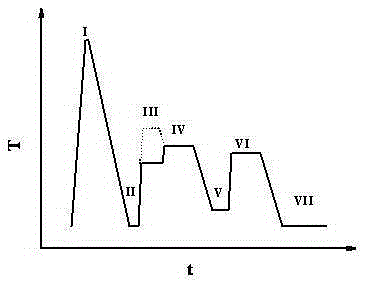Flexible cadmium telluride solar cell with graphene insertion layer
A technology of solar cells and insertion layers, applied in circuits, photovoltaic power generation, electrical components, etc., can solve problems such as unsatisfactory effect, thickness affecting battery electrical connection, device performance degradation stability, etc.
- Summary
- Abstract
- Description
- Claims
- Application Information
AI Technical Summary
Problems solved by technology
Method used
Image
Examples
Embodiment 1
[0021] I. First, deposit graphene (Gr) by CVD method, put Ni foil (M1) into the vacuum chamber, and evacuate to about 2×10 4 Pa, the substrate temperature is 900 0 C~1000 0 C, introduce argon gas mixed with 5% methane, the gas flow rate is 50 sccm, hydrogen gas is 500 sccm, the deposition time is about 50-120 s, and the cooling process is passed through 2000 sccm argon gas and 500 sccm hydrogen gas.
[0022] II. Next, deposit about 1 nm of Bi (D) and about 50 nm of Te (B) by evaporation.
[0023] III~IV. Subsequently, as attached figure 2 As shown by the solid line in process III, cadmium telluride (A) is prepared by evaporation method with a thickness of about 5000 nm, and the substrate temperature is 350 0 C, followed by evaporation of 400nm CdCl 2 , then annealed in air at 440 0 c.
[0024] V~VI. The deposition of cadmium sulfide (W) adopts the chemical water bath method, and the drugs used are all analytical reagents, prepared with secondary deionized water, and the...
Embodiment 2
[0027] I. Deposit graphene (Gr) by VD method, put Ni foil (M1) into the vacuum chamber, and evacuate to about 2×10 4 Pa, the substrate temperature is 900 0 C~1000 0 C, introduce argon gas mixed with 5% methane, the gas flow rate is 50 sccm, hydrogen gas is 500 sccm, the deposition time is about 50-120 s, and the cooling process is passed through 2000 sccm argon gas and 500 sccm hydrogen gas.
[0028] II. Next, deposit about 1 nm of Sb (D) and about 50 nm of Te (B) by evaporation.
[0029] III~IV. Subsequently, as attached figure 2 As shown by the dotted line in Process III, Cd(A) is prepared by the near-space sublimation method with a thickness of about 6000 nm and a deposition temperature of about 570 0 C, followed by evaporation of 400nm CdCl 2 , then annealed in air at 440 0 c.
[0030] V~VI. Deposition of cadmium sulfide (W) by sputtering method to deposit about 50nm, of which the purity of CdS target is 99.99%, and the background vacuum is ~10 -4 Pa, the working g...
PUM
 Login to View More
Login to View More Abstract
Description
Claims
Application Information
 Login to View More
Login to View More - R&D
- Intellectual Property
- Life Sciences
- Materials
- Tech Scout
- Unparalleled Data Quality
- Higher Quality Content
- 60% Fewer Hallucinations
Browse by: Latest US Patents, China's latest patents, Technical Efficacy Thesaurus, Application Domain, Technology Topic, Popular Technical Reports.
© 2025 PatSnap. All rights reserved.Legal|Privacy policy|Modern Slavery Act Transparency Statement|Sitemap|About US| Contact US: help@patsnap.com


